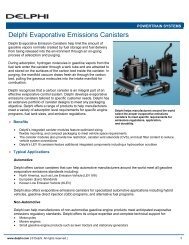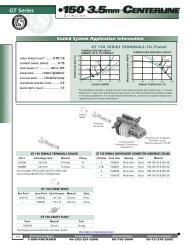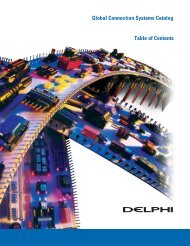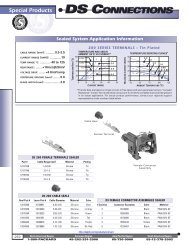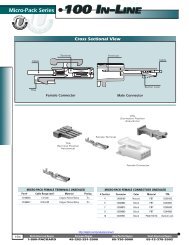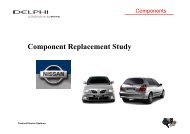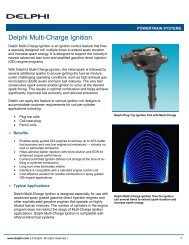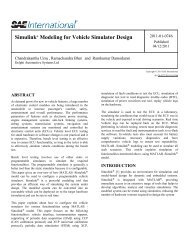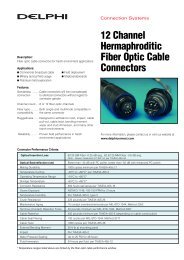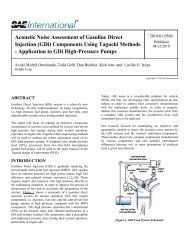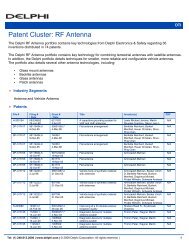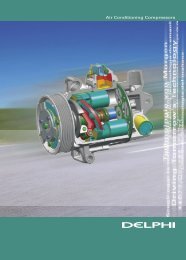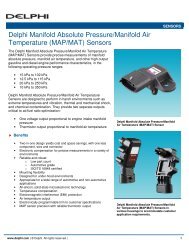Cavitation and Hydraulic Flip in the Outward-Opening GDi ... - Delphi
Cavitation and Hydraulic Flip in the Outward-Opening GDi ... - Delphi
Cavitation and Hydraulic Flip in the Outward-Opening GDi ... - Delphi
Create successful ePaper yourself
Turn your PDF publications into a flip-book with our unique Google optimized e-Paper software.
• Formation of a cavitation r<strong>in</strong>g, with irregular <strong>in</strong>ception<br />
locations around <strong>the</strong> circumference, at <strong>the</strong> entrance<br />
to <strong>the</strong> conical nozzle doma<strong>in</strong> of <strong>the</strong> valve-group<br />
• Additional downstream separate cavitation regions<br />
(patches) with limited circumferential spread, with<strong>in</strong><br />
<strong>the</strong> conical nozzle doma<strong>in</strong> (At 5 MPa fuel pressure, it<br />
appears as if <strong>the</strong> cavitation is caused by <strong>the</strong><br />
presence of <strong>the</strong> pressure tapp<strong>in</strong>g holes. This is not<br />
<strong>the</strong> case, as evidenced by absence of a<br />
correspondence at higher fuel system pressures).<br />
• Enhancement of <strong>the</strong> <strong>in</strong>tensity <strong>and</strong> <strong>in</strong>crease <strong>in</strong> <strong>the</strong><br />
number of <strong>the</strong> cavitation zones (patches) <strong>in</strong> <strong>the</strong><br />
conical nozzle, with <strong>the</strong> <strong>in</strong>crease of <strong>the</strong> fuel pressure<br />
from 5 MPa to 20 MPa.<br />
Although <strong>the</strong> imag<strong>in</strong>g data provides valuable <strong>in</strong>formation,<br />
<strong>the</strong> limitations of <strong>the</strong> optical arrangement does not permit<br />
dist<strong>in</strong>ction between cavitation <strong>in</strong>ception on <strong>the</strong> p<strong>in</strong>tle or<br />
<strong>the</strong> nozzle-seat walls. This is considered an important<br />
<strong>in</strong>formation with respect to <strong>the</strong> velocity-profile of <strong>the</strong><br />
liquid jet at <strong>the</strong> nozzle exit <strong>and</strong> its potential <strong>in</strong>fluence on<br />
<strong>the</strong> deviations of <strong>the</strong> spray cone-angle from that <strong>in</strong>tended<br />
by <strong>the</strong> nozzle design. Ano<strong>the</strong>r issue of <strong>in</strong>terest that <strong>the</strong><br />
experimental arrangement – <strong>and</strong> <strong>the</strong> imag<strong>in</strong>g data –<br />
does not allow is to discrim<strong>in</strong>ate between cavitation <strong>and</strong><br />
partial hydraulic flip: i.e. whe<strong>the</strong>r <strong>the</strong> “apparent” cavitation<br />
<strong>in</strong> <strong>the</strong> conical nozzle doma<strong>in</strong> is <strong>in</strong>deed cavitation (i.e.<br />
liquid to vapour phase-transfer) or is a visual<br />
consequence of <strong>the</strong> entra<strong>in</strong>ment of ambient air <strong>in</strong>to <strong>the</strong><br />
nozzle doma<strong>in</strong>. (This would require <strong>in</strong>jection <strong>in</strong>to a liquidfilled<br />
ambient, which would <strong>in</strong>hibit visualization of <strong>the</strong><br />
conical-sheet breakup structure.)<br />
COMPUTATIONAL INVESTIGATIONS<br />
The computational studies are undertaken <strong>in</strong> an attempt<br />
to assess <strong>the</strong> capability of current CFD methodology to<br />
elucidate <strong>the</strong> aforementioned uncerta<strong>in</strong>ties with regards<br />
<strong>the</strong> imag<strong>in</strong>g results, as well as to establish <strong>the</strong> qualitative<br />
<strong>and</strong> quantitative accuracy of <strong>the</strong> method to support <strong>the</strong><br />
valve-group design optimization process.<br />
The commercial CFD code AVL-FIRE [14] is used for <strong>the</strong><br />
simulation of <strong>the</strong> multi-fluid (liquid, vapour, ambient air)<br />
flow with<strong>in</strong> <strong>the</strong> <strong>in</strong>jector <strong>and</strong> its near-field ambient<br />
environment. The computational method adopts an<br />
<strong>in</strong>compressible multifluid approach that is based on <strong>the</strong><br />
f<strong>in</strong>ite-volume discretization <strong>and</strong> numerical solution of<br />
<strong>in</strong>dependent (but coupled) sets of conservation<br />
equations for <strong>the</strong> liquid <strong>and</strong> <strong>the</strong> gaseous (fuel vapour, air)<br />
phases [15]. The set of conservation equations comprise<br />
<strong>the</strong> Reynolds-averaged equations of <strong>the</strong> conservation of<br />
mass, momentum (Navier-Stokes equations) <strong>and</strong> <strong>the</strong><br />
total enthalpy of <strong>the</strong> components. In addition, transport<br />
equations for <strong>the</strong> k-epsilon turbulence model are solved<br />
to account for <strong>the</strong> stochastic effects of turbulence on <strong>the</strong><br />
transport process. The simultaneous solution of <strong>the</strong><br />
three equation system enables determ<strong>in</strong>ation of <strong>the</strong> fielddistributions<br />
of <strong>the</strong> liquid, vapour <strong>and</strong> air volume<br />
fractions.<br />
In <strong>the</strong> present publication, <strong>the</strong> results of iso-<strong>the</strong>rmal twofluid<br />
(liquid, vapour) <strong>and</strong> three-fluid (liquid, vapour,<br />
ambient air) simulations are presented, <strong>in</strong> order to<br />
underscore <strong>the</strong> significant difference <strong>in</strong> <strong>the</strong> simulation<br />
results - <strong>and</strong> <strong>in</strong>terpretation of <strong>the</strong> physical flow<br />
phenomena with<strong>in</strong> <strong>in</strong>jector valve group - between <strong>the</strong> two<br />
simulation cases.<br />
COMPUTATIONAL DOMAIN AND MESH - Figure 5<br />
presents <strong>the</strong> solution doma<strong>in</strong> <strong>and</strong> <strong>the</strong> computational<br />
mesh for calculation of <strong>the</strong> two-fluid (Fig. 5.a ) <strong>and</strong> threefluid<br />
(Fig. 5.b) flows. The computational doma<strong>in</strong> for <strong>the</strong><br />
two-fluid calculations is limited to <strong>the</strong> <strong>in</strong>jector <strong>in</strong>ternal<br />
space (it is bounded by <strong>the</strong> nozzle exit surface), while<br />
<strong>the</strong> computational doma<strong>in</strong> for three-fluid calculations<br />
extends <strong>in</strong>to <strong>the</strong> ambient air.<br />
The circumferential cyclic-symmetry <strong>and</strong> <strong>the</strong> planar<br />
symmetry of <strong>the</strong> <strong>in</strong>jector valve-group geometry is<br />
exploited to limit <strong>the</strong> solution doma<strong>in</strong> to a 1/10th segment<br />
of <strong>the</strong> complete geometry.<br />
Swirler channel<br />
Swirler cavity<br />
P<strong>in</strong>tle<br />
Conical nozzle<br />
Seat<br />
(a) Two-fluid flow<br />
simulation<br />
(b) Three-fluid flow<br />
simulation<br />
Figure 5 : Computational flow doma<strong>in</strong> <strong>and</strong> mesh of <strong>the</strong><br />
valve-group for two-fluid (liquid + vapour) <strong>and</strong> threefluid<br />
(liquid + vapour + ambient air) flow simulations<br />
INITIAL AND BOUNDARY CONDITIONS - The<br />
methodology for simulation of <strong>the</strong> flow <strong>and</strong> cavitation<br />
requires prescription of <strong>the</strong> liquid- <strong>and</strong> <strong>the</strong> gaseousphase(s)<br />
<strong>the</strong>rmo-physical conditions, for <strong>the</strong> <strong>in</strong>itial<br />
conditions <strong>and</strong> at <strong>the</strong> boundaries of <strong>the</strong> solution doma<strong>in</strong>.<br />
With respect <strong>the</strong> gaseous phase(s), this entails<br />
additional description of <strong>the</strong> physical conditions (c.f.<br />
bubble number density) [14].<br />
The <strong>in</strong>itial conditions for all calculations are <strong>the</strong> <strong>in</strong>jector<br />
<strong>in</strong>ternal flow doma<strong>in</strong> filled with liquid, at rest, with<br />
nom<strong>in</strong>al-zero (1. e-6) volume-fraction(s) of <strong>the</strong> gaseous<br />
phase(s). In <strong>the</strong> case of three-fluid calculations, <strong>the</strong>



